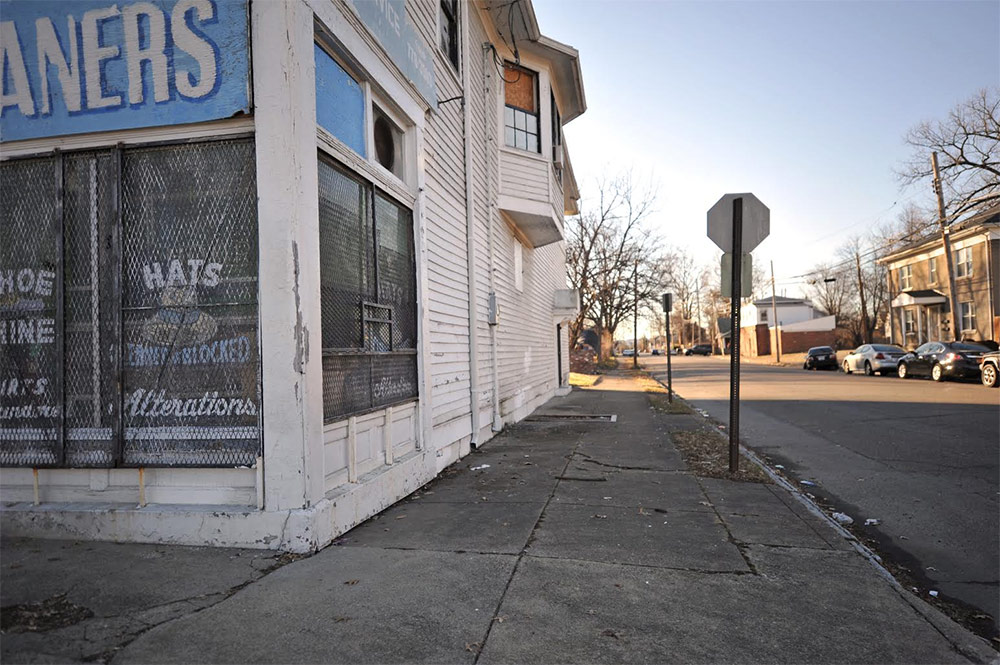Our readers sure know Downtown Louisville! We had a four-way tie for correctly identifying our last sidewalk challenge as Fourth Street looking south in front of the Brown Hotel near Broadway (all four entries came in at the exact same minute!). Nicely done, Sarah Cole, Matt Ruben, Barturtle, and Kyle. All four winners will receive a Broken Sidewalk magnet. For your chance to win a magnet, tell us where this sidewalk is located in the comments below. (The rules: Leave a real email so we can get in touch if you win; No repeat winners for four months; Comments must be left on this news roundup.) Good luck!
And now on with the week’s top urbanism news:
# History /// “A Palimpsest called Paris: Schuiten and Peeters’s urban fictions” for Damn 48. The Funambulist does a great job of digging up old urban projects, in the form of art, architecture, and renderings, that really stimulate the imagination. In this post they show us how the French saw the future of their cities. Funambulist
Urban regeneration: What recent research says about best practices. A recent review of a Lincoln Institute study shows what mayors, urban planners, and others think about the recent history of urban regeneration projects. What have we learned? What are we repeating? Journalist’s Resource
Mapping America’s most dangerous bridges. Its been a good week for terrifying maps. Heres one: a map of the most dangerous (not unsafe) bridges in the United States. Enjoy. Washington Post
Unearthed: Alyssa Loorya on Urban Archaeology. Alyssa Loorya leads Chrysalis Archaeology, a firm at the forefront of uncovering the remnants of history in the New York metro area. Amidst rapid change and constant redevelopment, Loorya’s work is a testament to how much remains under our feet or tucked beneath the floorboards. And while her team’s finds are interesting in their own right, she further argues for their value to the public and the developers that sometimes consider historic preservation to be at odds with their new plans. Here, Loorya takes on the supposed tension between preservation and development, shares the particularities of urban archaeology, and tells the fascinating stories of some of her favorite sites and finds. Urban Omnibus
Envisioning Change for a Contested Mumbai Neighborhood. This piece by Julia Cooke offers us two important things: First, an introduction to the amazing urban research/design team of URBZ; and second, a chance to see Dharavi as something more comprehensive than a ‘slum’. Curbed
A Chicago Community Puts Mixed-Income Housing To The Test. Lawrence Vale, an urban studies professor at MIT, has studied mixed-income housing in Chicago and other cities. “There are lots of assumptions about what the new neighborhoods should do to help low-income residents find role models or better social networks,” he says, “but the empirical evidence of that has been scant.” NPR
Black History Month and urban planning. The Urban Places & Spaces blog offers a brief history of African American engagement in urban planning. Urban Places & Spaces
The DNA of Cities. Abdelbaseer A. Mohamed offers a DNA version about city form and function. This Big City
In Newark, Love Is … Buying a Vacant Lot. Louisville! This is a cool idea, but with less restrictions. Next City
Could tent cities be the magic bullet for housing the homeless? Not a fan of “magic bullets,” but tent cities are a reasonable mitigation that could provide some real change—and dignity—to the lives of our homeless populations. Urbanful



Corner of Catalpa St. and Southern Ave.